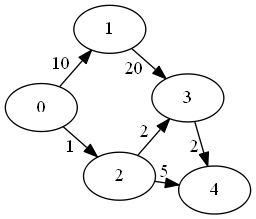All pairs shortest path and transitive closure
The all pairs shortest path problem is a classic one involving finding the shortest path between all vertices. The idea is to be able to perform the query for the shortest path distance between \( i \) and \( j \) in \( O(1) \). A simple dynamic programming algorithm is the Floyd–Warshall algorithm which doesn’t work for negative weighted cycles.
Given the following graph

the following dynamic programming algorithm computes the all-pairs-shortest-path distance matrix
#include <iostream>
#include <vector>
#include <iterator>
using namespace std;
vector<vector<int>> allPairsShortestPath(const vector<vector<int>>& adjMatrix) {
// Assumes adjMatrix hasn't null dimensions
vector<vector<int>> result(adjMatrix);
// Consider each vertex as an intermediate vertex in a path
for (int k = 0; k < adjMatrix.size(); ++k) {
// Form all possible paths
for (int i = 0; i < adjMatrix.size(); ++i) {
for (int j = 0; j < adjMatrix.size(); ++j) {
if (result[i][k] + result[k][j] < result[i][j])
result[i][j] = result[i][k] + result[k][j];
}
}
}
return result;
}
int main() {
const int INF = 10000; // Caveat: this should be chosen not to overflow
vector<vector<int>> adjMatrix = {
{ 0, 10, 1, INF, INF },
{ INF, 0, INF, 20, INF },
{ INF, INF, 0, 2, 5 },
{ INF, INF, INF, 0, 2 },
{ INF, INF, INF, INF, 0 }
};
auto result = allPairsShortestPath(adjMatrix);
cout << "All pairs shortest path matrix:" << endl;
for (auto& v : result) {
copy(v.begin(), v.end(), ostream_iterator<int>(cout, "\t"));
cout << endl;
}
return 0;
}Output
All pairs shortest path matrix:
0 10 1 3 5
10000 0 10000 20 22
10000 10000 0 2 4
10000 10000 10000 0 2
10000 10000 10000 10000 0
As it can easily be guessed, the algorithm isn’t particularly efficient and is \( O(N^3) \). There are other faster algorithms for the all-pairs-shortest-path problem but Floyd-Warshall’s is an elegant example of dynamic programming solution that can also be used for the transitive closure problem in graph theory. It is trivial to modify the algorithm above to answer the question Is it possible to get from node x to y in one or more steps?